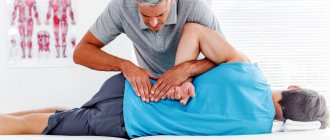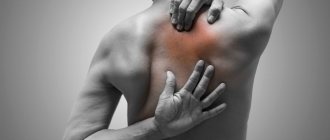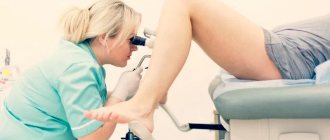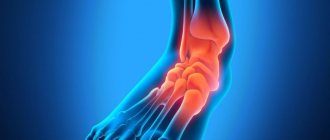Video
Pain under the shoulder blade. Question answer.
Topic: Questions and Answers
Pain under the shoulder blade
Topic: Encyclopedia of diseases
Title
- Pain under the left shoulder blade
- Pain under the right shoulder blade
- Diagnostics
- Treatment methods
Pain under the shoulder blade is a fairly common complaint among patients and often presents difficulties both for diagnosis and treatment. The pain can be localized both under the left and under the right shoulder blade.
Does your shoulder blade hurt?
In our turbulent times, back pain, as well as pain in the shoulder blades and between them, are quite common. Moreover, both among the older generation and among young people. This unbearable discomfort very often still torments office people or people with sedentary work. Such pain can radiate to different parts of the spine. Pain in the area of the shoulder blades is the most common complaint to doctors when dealing with back and spine problems.
Soreness in the shoulder blades is a fairly broad concept, and the doctor needs to understand in which area the pain is localized in order to correctly diagnose the disease. That is why it is customary to distinguish the following varieties:
- Pain under the shoulder blade (left or right);
- Pain between the shoulder blades;
- Pain directly in the shoulder blades.
Why does my back hurt between and under my shoulder blades?
The causes of pain in the shoulder blade area can be all sorts of diseases. Basically, they are associated with the spine. Depending on the location of the pain and the presence of accompanying symptoms, after conducting the necessary tests and examinations, the doctor will determine the cause of the illness tormenting you.
IV. Let's take a closer look at the most common cases of pain in the shoulder blades.
What do such causes of pain as long-term computer work, weakness of the cervical and thoracic muscles, and stereotypic movements of the upper limbs have in common?
As a rule, the basis is an increase in muscle tone, i.e. muscle-tonic syndrome and myofascial pain syndrome (MFPS). Myofascial syndrome is characterized by the presence of trigger points, which are a tangle of individual contracted muscle fibers, against the background of which the bulk of the muscle affected by the triggers becomes weaker. This occurs due to the reflex response of our central nervous system, which receives information that the muscle fibers in the trigger zones are in increased tone, and since an excessive increase in tone in the muscle is energy-consuming for the body, it gives the command to weaken the muscle. A logical question arises: how can such opposite conditions as hypertonicity and weakness be combined?
In this image we see the classic pose of a person working at a computer. With this position of the body, the following biomechanical changes are observed: 1. The shoulder blades and shoulders shift forward; the muscles of the interscapular region are weakened (middle and lower portions of the trapezius muscle, rhomboid muscles), but at the same time the pectoral muscles are shortened. 2. There is an increase in thoracic kyphosis (i.e., a stooped back) 3. Compensatory hyperextension of the cervical spine - weakness of the muscles of the anterior group of the neck, and hypertonicity of the extensors of the neck and head. That is, when any muscle group is weakened, the tone in the antagonist muscles reflexively increases. Such biomechanical changes are called upper cross syndrome. In the clinical picture, in addition to burning pain in the area of the shoulder blades, such patients may also experience a feeling of stiffness, discomfort in the cervical spine and headache. The pain caused by this condition responds very well to treatment using soft manual therapy techniques; a course of exercise therapy with further exercises at home is also a prerequisite for achieving a lasting result. The method of acupuncture has proven itself well; this method helps to cope with muscle strain in the cervical-collar area and relieve psycho-emotional stress.
Consider another cause of burning pain in the area of the shoulder blades, namely degenerative-dystrophic changes in the cervical spine (osteochondrosis, spondyloarthrosis, spondylosis) and disc herniations. The muscles of the upper thoracic region receive innervation from the cervical roots of the spinal cord. Thus, the presence of dystrophic changes in this area leads to the development of myofascial syndrome in the rhomboid muscle, the levator scapulae muscle and the upper portion of the trapezius muscle.
Domestic authors have found that damage to the disc, joints and ligaments of the cervical spine at the level of C4-C5, sometimes C5-C6, leads to the development of MFPS in the rhomboid muscle (PRESENTED IN THE FIGURE). When the rhomboid muscle is affected, the pain is localized along the inner edge of the scapula, sometimes spreading to the shoulder girdle (the area of pain distribution is indicated in red), but never spreads to the cervical region, unlike the pain coming from the levator scapulae muscle and the upper portion of the trapezius muscle. In addition to pain, crunching and clicking sounds are often observed when moving the shoulder blade, but the movements themselves are not limited. The usual position for such patients is a slouched back.
Damage to internal organs, accompanied by referred pain in the shoulder blades. Heart. With ischemia (lack of blood supply) of the heart muscle, a symptom such as burning pain, localized in the area of the left shoulder blade, left arm, neck and lower jaw, is often observed. Most often, pain during myocardial ischemia occurs during physical activity, in contrast to myofascial pain syndrome, which manifests itself at rest and is less intense. Pain during myocardial ischemia is often accompanied by panic and fear of death. As you can see, pain in the thoracic region can be caused by a variety of pathological conditions that require careful collection of complaints and medical history, differential diagnosis and exclusion of the most dangerous diseases first. At the same time, you should not worry too much about it; in the vast majority of cases, the pain is benign in nature and, with the right tactics, responds well to treatment.
Does it hurt under your shoulder blade?
- Sharp pain between the shoulder blades, any movement causes pain;
- Severe cutting pain between the shoulder blades;
- The pain is just below the shoulder blades, the pain is rather dull, and it is most noticeable at the moment when the arms are raised;
- Drawing pain under the shoulder blades, down the spine to the lower back, compressing the chest;
- Aching pain under the left shoulder blade, sometimes it can radiate a little lower;
- Constant cutting pain under the left shoulder blade, with any body movement the pain intensifies, when moving the left arm the pain is clearly sharper, inhalation and exhalation is difficult with painful sensations;
- For several days, there has been aching pain between the shoulder blades (closer to the right side). The pain occurs mainly after walking or standing for a long time. First there is pain, which then turns into burning or cold;
- The pain radiates through to the right shoulder blade. If you raise your right hand and move it to the side and hold it like that, the pain goes away.
Post-medication procedures
After drug treatment and relief from pain in the area of the right shoulder blade, the patient is recommended to undergo a course of therapy aimed at restoring the immune system and strengthening the musculoskeletal system in the chest, neck and spine. These procedures help minimize relapse of the disease.
To start practicing therapeutic exercises, you need to make sure that the source of pain is completely eliminated, and the pain itself is reduced to a minimum. Any physical activity is carried out exclusively with the permission of a doctor and is carried out in the presence of a specialist.
Gymnastics that strengthens the shoulder blades
Why do my shoulder blades hurt?
Typically, pain emanating from the muscles gives a burning sensation between the shoulder blades, heaviness, and a load in the upper back. But as soon as you move your shoulders, the pain immediately goes away. If the aching pain between the shoulder blades does not go away after changing body position and additionally radiates to the heart area, then its source can be both heart disease and problems in the thoracic spine. In order to identify the true cause, a comprehensive diagnosis is necessary.
Our diagnostics include:
- consultation with a neurologist;
- special orthopedic tests;
- dynamic active and passive tests;
- local palpation examination of damaged joints;
- assessment of the state of the musculoskeletal system: posture;
- gait;
- uniform distribution of load on joints;
- range of motion;
- joint stability and strength;
If necessary, the doctor may also prescribe:
- MRI;
- Ultrasound;
- X-ray;
- Lab tests;
- Diagnostic puncture of the joint.
Therapeutic measures in a hospital setting
It is not recommended to treat yourself. It is better to seek the help of specialists and undergo complex treatment, which will be selected by the doctor according to an individual scheme.
Complex therapy involves the use of medications in combination with physiotherapeutic procedures and therapeutic exercises.
If there is an inflammatory process, the doctor prescribes a course of NSAIDs (Movalisa, Dicloberla). To eliminate muscle spasms, muscle relaxants (Baralgin, Mydocalm, Sirdalud) are indicated. When the cause of pain in the interscapular area lies in problems with internal organs, the doctor selects medications from certain pharmacological groups. In this case, antibiotics, hepatoprotectors, diuretics, analgesics, etc. are indicated.
Along with medications, physiotherapeutic procedures may be recommended:
- laser therapy;
- acupuncture;
- electrophoresis using lidase and novocaine;
- massage;
- magnetic therapy.
The gymnastic complex is prescribed on an individual basis, taking into account the characteristics of the pathology, the nature of the pain, and the patient’s well-being.
Treatment of pain in the shoulder blades
For each of our patients, depending on their condition, treatment is selected individually by the doctor. At the Alan Clinic Center for Neurology and Orthopedics, there is a whole range of methods for this, ranging from time-tested massage and physical therapy to modern techniques.
Of course, we can alleviate your condition, no matter what stage your illness is, but the sooner you do this, the more productive the treatment and speedy recovery will be.
We have at our disposal the following methods:
- Manual therapy;
- Osteopathy - treatment by the hands of a doctor, a gentle effect on the musculoskeletal system, nervous and vascular systems, internal organs;
- Yumeiho therapy;
- Medical massage;
- Acupuncture - exposure to biologically active points with microneedles;
- Laser reflexology is a painless effect on reflexogenic zones and points;
- Tsubotherapy is a gentle effect on the body’s reflex points;
- Pharmacopuncture - the introduction of medicinal drugs of natural origin to the source of the problem;
- Plasma therapy is the introduction of the patient’s own purified blood into the site of the disease;
- Isometric kinesiotherapy - individual gymnastic techniques/exercises, according to indications, with elements of joint massage;
- Kinesiotherapy using the Exart installation;
- Kinesio taping;
- Ozone therapy - treatment with active oxygen;
- Physiotherapy;
- Physiotherapy with enzyme preparations;
- Therapeutic droppers;
- Hirudotherapy - treatment with leeches;
- Botulinum therapy - treatment with botulinum toxin;
- Intra-articular injection of synovial fluid endoprostheses;
- Intra-articular blockades.
Effective therapeutic techniques
After determining the root cause of interscapular pain, the patient may need to consult with a cardiologist, neurologist, or gastroenterologist. Until you receive medical help, you can try to relieve the pain syndrome on your own; you should not endure it for long. There are some harmless methods to relieve pain.
Gymnastic exercises
A gymnastics complex will help relieve discomfort:
- We place our palms on our shoulders and perform several circular movements back and forth.
- We raise our palms to the top, then our arms completely, lock them together, lower our heads, and concentrate our gaze on the fingers.
- We bring and spread the shoulder blades.
- We perform body turns alternately to the right and left.
Medicines
Taking medications without medical advice is contraindicated, as this may worsen the situation.
In cases where the cause of pain in the intervertebral region is associated with spinal diseases, the doctor may prescribe treatment with drugs from the NSAID group:
- Diclofenac;
- Indomethacin;
- Movalis;
- Ibuprofen;
- Nimesulide;
- Meloxicam;
- Naproxen;
- Voltaren, etc.
As an auxiliary therapy, the affected area can be treated with external agents: Fastum gel, Capsicam, Amelotex, Nise gel.
After the pain has eased, you can resort to local medications with an irritating effect:
- Efkamena;
- Menovazina;
- Finalgona.









